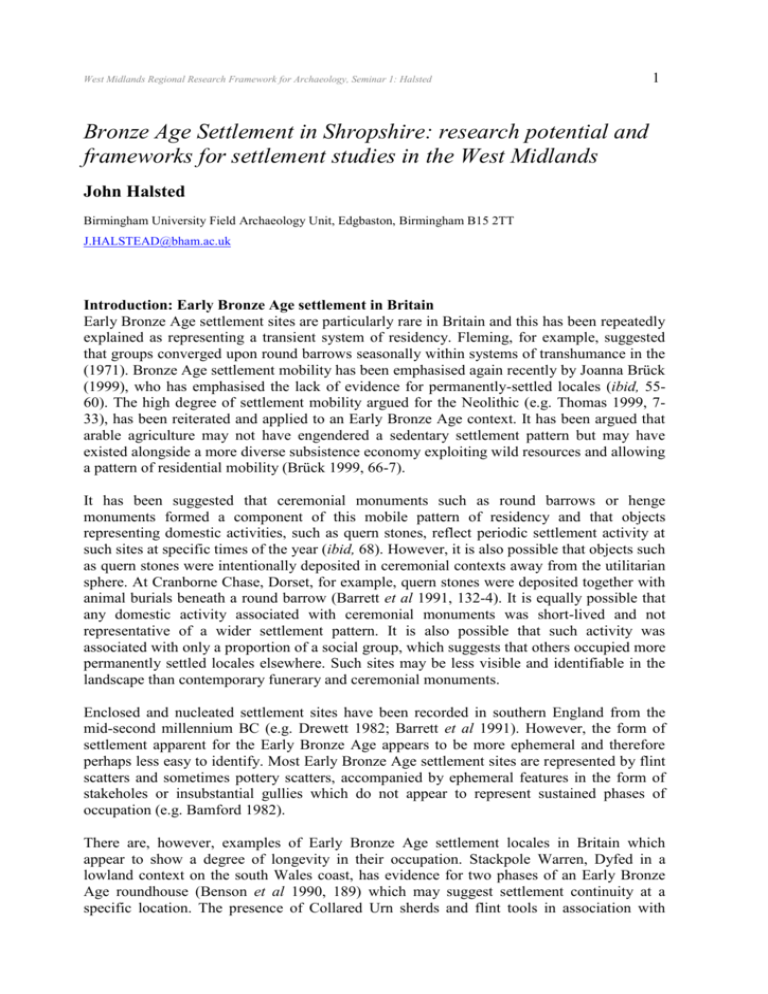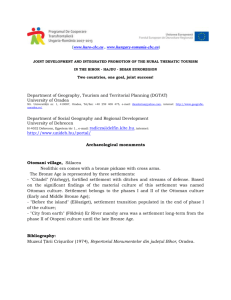Early Bronze Age settlement in Britain
advertisement

West Midlands Regional Research Framework for Archaeology, Seminar 1: Halsted 1 Bronze Age Settlement in Shropshire: research potential and frameworks for settlement studies in the West Midlands John Halsted Birmingham University Field Archaeology Unit, Edgbaston, Birmingham B15 2TT J.HALSTEAD@bham.ac.uk Introduction: Early Bronze Age settlement in Britain Early Bronze Age settlement sites are particularly rare in Britain and this has been repeatedly explained as representing a transient system of residency. Fleming, for example, suggested that groups converged upon round barrows seasonally within systems of transhumance in the (1971). Bronze Age settlement mobility has been emphasised again recently by Joanna Brück (1999), who has emphasised the lack of evidence for permanently-settled locales (ibid, 5560). The high degree of settlement mobility argued for the Neolithic (e.g. Thomas 1999, 733), has been reiterated and applied to an Early Bronze Age context. It has been argued that arable agriculture may not have engendered a sedentary settlement pattern but may have existed alongside a more diverse subsistence economy exploiting wild resources and allowing a pattern of residential mobility (Brück 1999, 66-7). It has been suggested that ceremonial monuments such as round barrows or henge monuments formed a component of this mobile pattern of residency and that objects representing domestic activities, such as quern stones, reflect periodic settlement activity at such sites at specific times of the year (ibid, 68). However, it is also possible that objects such as quern stones were intentionally deposited in ceremonial contexts away from the utilitarian sphere. At Cranborne Chase, Dorset, for example, quern stones were deposited together with animal burials beneath a round barrow (Barrett et al 1991, 132-4). It is equally possible that any domestic activity associated with ceremonial monuments was short-lived and not representative of a wider settlement pattern. It is also possible that such activity was associated with only a proportion of a social group, which suggests that others occupied more permanently settled locales elsewhere. Such sites may be less visible and identifiable in the landscape than contemporary funerary and ceremonial monuments. Enclosed and nucleated settlement sites have been recorded in southern England from the mid-second millennium BC (e.g. Drewett 1982; Barrett et al 1991). However, the form of settlement apparent for the Early Bronze Age appears to be more ephemeral and therefore perhaps less easy to identify. Most Early Bronze Age settlement sites are represented by flint scatters and sometimes pottery scatters, accompanied by ephemeral features in the form of stakeholes or insubstantial gullies which do not appear to represent sustained phases of occupation (e.g. Bamford 1982). There are, however, examples of Early Bronze Age settlement locales in Britain which appear to show a degree of longevity in their occupation. Stackpole Warren, Dyfed in a lowland context on the south Wales coast, has evidence for two phases of an Early Bronze Age roundhouse (Benson et al 1990, 189) which may suggest settlement continuity at a specific location. The presence of Collared Urn sherds and flint tools in association with West Midlands Regional Research Framework for Archaeology, Seminar 1: Halsted 2 charred cereal grains (ibid, 187) may suggest that domestic settlement at this site focussed upon a location favourable for cereal cultivation in the early second millennium BC. Similarly, in a contrasting upland environment at Lairg in northern Scotland, evidence has been recorded for Early Bronze Age roundhouses succeeding each other on the same spot (McCullagh & Tipping 1998, 38). Saddle querns and naked barley seeds recorded at Lairg (ibid,) also suggest an association with arable agriculture in an upland context. To what extent such cereals were grown as well as processed in such contexts is unknown. However, the presence of settlement locales at higher altitudes supports current debates which have questioned the notion of environmentally and economically marginal locations as having inhibited settlement in prehistory (Young & Simmonds 1999). Early Bronze Age settlement recorded in the vicinity of the West Midlands Locations which show evidence for settlement in the Early Bronze Age have also been recorded in areas adjacent to the West Midlands region. The sites at Oversley Farm (Garner 2001 and forthcoming), Arthill Heath Farm (Nevell 1988) and Tatton Park (Higham & Cane 1999) are all situated close to the River Bollin in Cheshire. All have evidence for structures with radiocarbon dates, which when calibrated, fall within the late third and early second millennia BC. These sites represent the only recorded Early Bronze Age structures in the counties bordering Wales. There are three important points to make about these sites: 1. They show that Early Bronze Age settlement locales exist in a lowland context in close proximity to rivers and water sources and appear to have a preference for well-drained sand and gravel situations. 2. Radiocarbon dates from these sites suggest that comparable locations were chosen for settlement potentially from the early third millennium and early to late second millennium BC. Radiocarbon dates and the ceramic assemblage from Oversley farm (Garner 2001) suggest that one location was occupied recurrently during the Bronze Age 3. The location of these sites in relation to the known distribution of Early Bronze Age barrows in Cheshire suggests that they may have been sited at an intentional distance from contemporary funerary and ceremonial monuments, the nearest of which lie between 1 and 4 kms away from each site. The presence of a Middle Bronze Age roundhouse in a comparable position in the upper Severn Valley at Glanfeinion, Powys, on well-drained gravels above the floodplains of the river (Britnell et al 1997), suggests that this settlement pattern extended beyond Cheshire. It may also suggest a degree of settlement continuity from the Early to Middle Bronze Age. Early Bronze Age settlement in Shropshire There is clearly the potential, therefore, for Early Bronze Age settlement sites such as those recorded in lowland Cheshire to be present in the West Midlands counties, including Shropshire. It is also possible that this region has settlement locales that were occupied repeatedly during the Bronze Age. However, no Early Bronze Age settlement structures have been recorded in Shropshire. A hearth associated with fragments of Beaker pottery and a flint scatter at Rock Green, Ludlow West Midlands Regional Research Framework for Archaeology, Seminar 1: Halsted 3 (Carver & Humler 1991), may represent a transient settlement episode and appears to be consistent with the ephemeral nature of settlement evidence recorded for the Late Neolithic and Early Bronze Age in Britain generally. Evidence for two episodes of tree clearance in mid-Shropshire dating to the Late Neolithic/Early Bronze Age and the Middle Bronze Age, have been recorded as part of the North West Wetlands Survey (Leah et al 1998, 53) together with evidence for cereal cultivation (ibid, 66-67). Despite the possibility that such samples represent localised environments only (ibid, 61), it is clear that further settlement locales remain to be identified in the county. In Shropshire the only clear indication of Bronze Age activity across the landscape is in the form of ceremonial monuments and limited stray finds of Bronze implements. It may, however, be possible to infer the location of a general settlement pattern by examining their context in the landscape. The relationship between drift geology and the location of round barrows in north-west Shropshire The recorded Early Bronze Age settlement sites in Cheshire all lie upon sand and gravel geology, and lowland Middle Bronze Age sites in Wales also appear to be located in similar well-drained contexts. It may be possible in Shropshire therefore to examine the distribution of barrows in relation to drift geology in the lowlands of the county, in order to establish the extent to which barrow sites reflect areas of lowland settlement. The area examined is in north-west Shropshire, southern Cheshire, and the border with the Welsh uplands. Although there is not a distinctive association between barrows and geology, there appears to be a slightly greater number (51) recorded on sand and gravel contexts than on boulder clays (36) in a lowland context. The distance between settlement sites and barrows in Cheshire of around 1–4 kms suggests that the monuments were within easy reach of settlement locales but not necessarily contiguous with them. Barrows may have been situated in landscape zones that were occupied on a seasonal or temporary basis. It is interesting to note in this context that barrows have also been recorded on boulder clays and in upland contexts that may have been more marginal in this period. Therefore barrows may have been situated in areas of contrasting land use, and used within agricultural cycles or social events that may have taken place away from more permanent nodes of settlement. This suggests settlement mobility, but such settlement mobility may not necessarily have required the wholesale movement of a group from a fixed settlement locale. The relationship between round barrows and metalwork finds in Shropshire It is possible that the distribution of Early Bronze Age metal artefacts in Shropshire may also reflect a relationship between settlement and ceremonial monuments. There does appear to be a general relationship between metal axe finds and barrow groups in Shropshire, though the majority of axes were found between 0.5 and 2 kms from the nearest barrow, suggesting an alternative focus in the local landscape for their deposition. The location of these finds is not inconsistent with the relationship between settlement sites and barrows in northern Cheshire. It is possible therefore that these finds may represent nodes West Midlands Regional Research Framework for Archaeology, Seminar 1: Halsted 4 of residency away from barrows but close enough to allow limited movement to ceremonial monuments from fixed settlement nodes. However, the fact that no Early Bronze Age axes have been recorded from settlement sites undermines this interpretation. It is possible that the deposition of Early Bronze Age axes is removed from the context of their utilitarian sphere at the end of their life cycle (e.g. Bradley 1990; Needham 1993). The fact that Early Bronze Age axes have been found at Titterstone Clee (Chitty 1926, 235-6) and the Wrekin, Shropshire, may have been influenced by perceptions of such hills as significant ritual foci in the landscape (Bradley 2000). The fact that a number of hilltops including Titterstone Clee and Sharpstones Hill (Barker et al 1991) also have evidence for Bronze Age funerary activity may support this. It is possible that neither barrows nor metalwork finds accurately reflect the location of settlement nodes in the Early Bronze Age. The location of settlement sites can perhaps only be inferred from the situations of known Early and Middle Bronze Age settlement sites that have been recorded in Cheshire and Wales. The relationship between settlement, ceremonial foci and locations of artefact deposition needs to be clarified in order for social and economic interactions in the period to be more fully understood. The identification of Early Bronze Age settlement sites in the West Midlands The evidence from Arthill Heath Farm, Tatton Park and Oversley Farm in Cheshire suggest that similar contexts witnessed phases of occupation from the late third millennium into the mid-late second millennium BC. In the case of Oversley Farm, the evidence suggests that specific points in the landscape were repeatedly chosen for settlement in prehistory. These sites do not necessarily equate with the location of ceremonial monuments or the deposition of metal objects in the Early Bronze Age. Therefore the identification of further such sites in the landscape is problematic. All Early Bronze Age settlement sites to the north in Cheshire and in Wales have been found by chance, either by random trial trenching as part of developer funded projects through PPG16 planning policy, or through the excavation of later Romano-British or Medieval settlements during research excavations. In order to identify Early Bronze Age settlement sites in the West Midlands we should be looking more widely around barrow cemeteries. It is necessary to identify suitable locations for settlement within c. 4 kms radius of round barrows, using the location of settlement sites in Cheshire as a precedent. This would require an examination of well-drained locations in close proximity to water sources with an environment suited to cultivation in the period. This can be achieved most realistically by a combination of selective fieldwalking, test pitting and environmental sampling, alongside existing PPG16 developer funded excavation in the landscape and assessment of data (particularly environmental) obtained from the excavation of round barrows and ring ditches in the West Midlands region. The excavation of flint scatters following fieldwalking surveys may also increase the understanding of Early Bronze Age settlement and enable settlement patterns to be measured against the prevailing interpretation of transient and mobile settlement envisaged for southern England. The fact that Early Bronze Age settlement sites have been recorded in the same location as later episodes of settlement, also suggests that greater emphasis should be placed on identifying phases of prehistoric settlement when Romano-British or Medieval sites are excavated, as part of PPG16 excavation specifications. West Midlands Regional Research Framework for Archaeology, Seminar 1: Halsted 5 References Bamford, H.M. 1982 Beaker Domestic Sites in the Fen Edge and East Anglia (East Anglian Arch Rep 16. Norfolk: Norfolk Archaeological Unit) Barker, PA, Haldon, R, & Jenks, WE, 1991 Excavations on Sharpstones Hill near Shrewsbury, 1965-71. In Carver, MOH (ed), Prehistory in Lowland Shropshire, Trans Shropshire Arch Hist Soc, 67, 15-57 Barrett, J, Bradley, R & Green, M, 1991 Landscape Monuments and Society; the prehistory of Cranborne Chase (Cambridge: Cambridge University Press) Benson, DG, Evans, JG, Williams, GH, Darvill, T & David, A, 1990 Excavations at Stackpole Warren, Dyfed, Proc Prehist Soc, 56, 179-245 Bradley, R, 1990 The Passage of Arms: an archaeological analysis of prehistoric hoards and votive deposits (Cambridge: Cambridge University Press) Bradley, R, 2000 An Archaeology of Natural Places (London: Routledge) Britnell, WJ, Silvester, RJ, Gibson, AM, Caseldine, AE, Hunter, KL, Johnson, S, HamiltonDyer, S, & Vince, A, 1997 A Middle Bronze Age round-house at Glanfeinion, near Llandinam, Powys, Proc Prehist Soc, 63, 179-97 Brück, J, 1999 What’s in a settlement? Domestic practice and residential mobility in Early Bronze Age Southern England. In Brück, J & Goodman, M (eds), Making Places in the Prehistoric World: themes in settlement archaeology (London: UCL Press), 52-75 Carver, MOH & Humler, MR, 1991 Excavations at Rock Green, Ludlow. In Carver, MOH (ed), Prehistory in Lowland Shropshire, Trans Shropshire Arch Hist Soc, 67, 84-97 Chitty, LF, 1926 Notes on Prehistoric Implements, Trans Shropshire Arch Soc, 10, 233-46 Drewett, P, 1982 Later downland economy and excavations at Black Patch, East Sussex, Proc Prehist Soc, 48, 321-400 Fleming, A, 1971 Territorial patterns in Bronze Age Wessex, Proc Prehist Soc, 37, 138-66 Garner, D, 2001 The Bronze Age of Manchester Airport: Runway 2’. In Brück, J (ed), Bronze Age Landscapes. Transition and transformation (Oxford: Oxbow Books), 41-56 Garner, D. Forthcoming. Manchester Airport Second Runway: the Excavations at Oversley Farm (Oxford: Oxbow Books) Higham, NJ & Cane, T, 1999 The Tatton Park Project, Part 1: Prehistoric to sub-Roman settlement and land use, J Chester Arch Soc, 74, 1-61 West Midlands Regional Research Framework for Archaeology, Seminar 1: Halsted 6 Leah, MD, Wells, CE, Stamper, P, Huckerby, E, & Welch, C, 1998 The Wetlands of Shropshire and Staffordshire (North West Wetlands Survey 5. Lancaster: Lancaster University Archaeological Unit) McCullagh, RPJ & Tipping, R, 1998 The Lairg Project 1988-1996. The Evolution of an archaeological landscape in Northern Scotland (Edinburgh: Star Monograph 3). Needham, S, 1993 Displacement and exchange in archaeological methodology. In Scarrre, C and Healy, F (eds), Trade and Exchange in Prehistoric Europe (Oxford: Oxbow Monograph 33), 161-69 Nevell, M, 1988 Arthill Heath Farm. Trial excavations on a prehistoric settlement 1987-88. Interim report, Manchester Arch Bull, 3, 4-13 Thomas, J, 1999 Understanding the Neolithic (London: Routledge) Young, R & Simmonds, T, 1999 Debating marginality: archaeologists on the edge? In Brück, J & Goodman, M (eds), Making Places in the Prehistoric World: themes in settlement archaeology (London: UCL Press), 198-211








